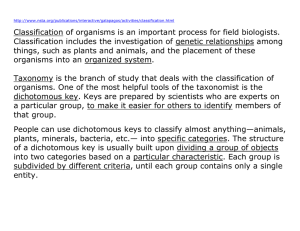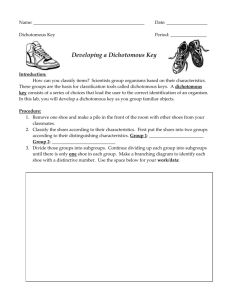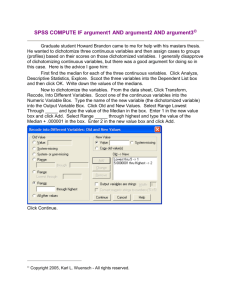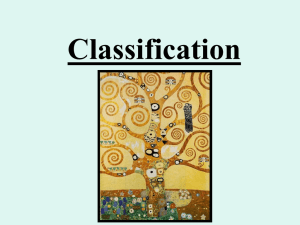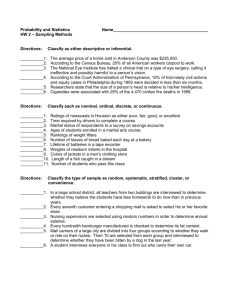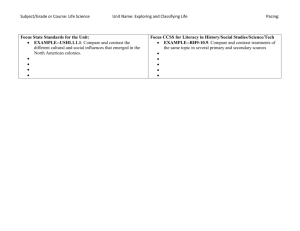GK-12 Lesson Plans
advertisement
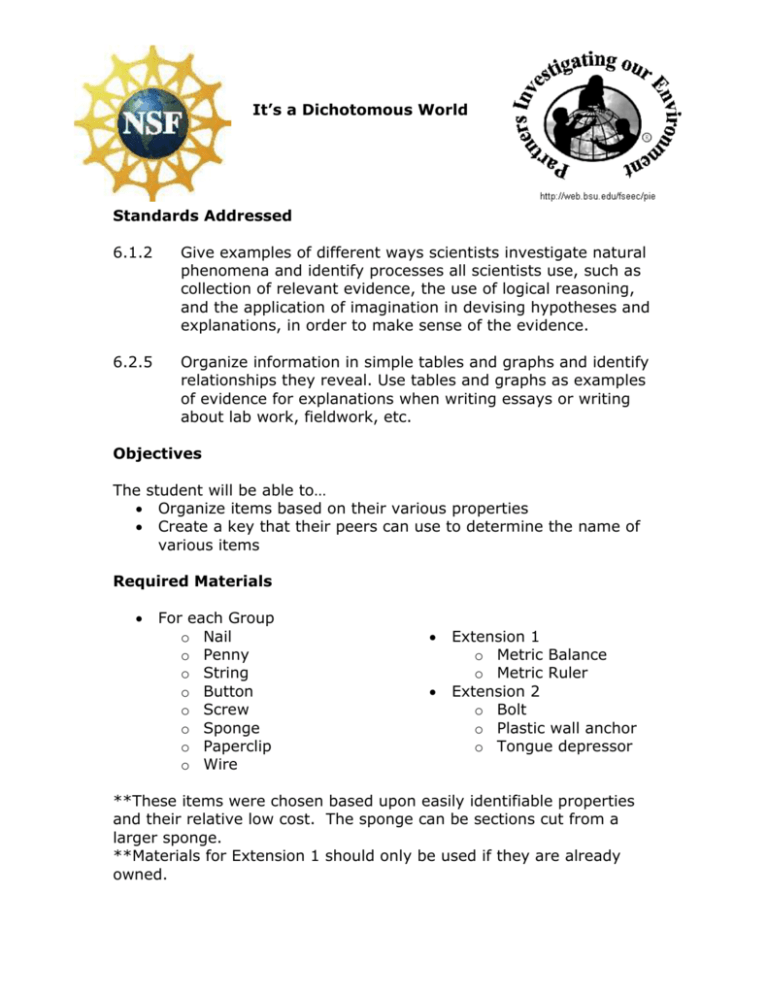
It’s a Dichotomous World Standards Addressed 6.1.2 Give examples of different ways scientists investigate natural phenomena and identify processes all scientists use, such as collection of relevant evidence, the use of logical reasoning, and the application of imagination in devising hypotheses and explanations, in order to make sense of the evidence. 6.2.5 Organize information in simple tables and graphs and identify relationships they reveal. Use tables and graphs as examples of evidence for explanations when writing essays or writing about lab work, fieldwork, etc. Objectives The student will be able to… Organize items based on their various properties Create a key that their peers can use to determine the name of various items Required Materials For each Group o Nail o Penny o String o Button o Screw o Sponge o Paperclip o Wire Extension 1 o Metric Balance o Metric Ruler Extension 2 o Bolt o Plastic wall anchor o Tongue depressor **These items were chosen based upon easily identifiable properties and their relative low cost. The sponge can be sections cut from a larger sponge. **Materials for Extension 1 should only be used if they are already owned. Lesson Introduction Organizing things by grouping those with common characteristics is called Classification. Everyday, you classify items by sorting objects and putting them in to a specific place; sock drawers, computer files, items in the garage. It is also an important part of the scientific process to classify things because it highlights the differences and similarities between different things. Many concepts in science are based on facts produced from classifications; an example of this is in chemistry. The periodic table orders atoms based upon their physical properties. Geologists classify minerals by observable physical and chemical characteristics. In Biology living things are classified by a many different taxonomic categories. Scientists use a variety of classification methods to organize the world around them and a common way to arrange the classification system is to use a Key. A Key is usually organized into a series of choices that lead to the name of a given item. Keys are able to guide others to use a system of classification to classify items. One of the most commonly used keys is the Dichotomous Key. Dichotomous means divided into two Figure 1: Basic Dichotomous Key for four animals parts, therefore, in Dichotomous Keys two choices are always given in each step to narrow down the classification for an item until only once choice is left (Figure 1). In this activity the students will create their own dichotomous key for some common items. This Classification activity can be used as a lead-in activity for many of the other PIE lessons. Pre-Activity To introduce the concept of a Dichotomous Key to students have each student (or half of the students depending upon class size) take off their right shoes and place on the floor in the center of the classroom. As a class develop a dichotomous key or system of dual divisions with the help of the instructor. The classification system should be drawn on the board as the divisions are made similar to figure 1. Another example is in the Chart Examples section after the references. First, students should observe the shoes to note similarities and differences. Then they can choose a category that some of the shoes have and some do not. Have them write it down. For each of those groups students can subdivide the shoes again into a category that describes some but not others. Every time they divide a set of shoes, it should be into 2 groups. These divisions are based on some visible trait that some have and others do not. They should continue dividing the shoes until there is only one in each category. This is a dichotomous key. They can test their key by tracing some of the left shoes through each of the descriptive categories to see if following the divisions leads them to match it with its mate. Activity Break students in to groups of 3-6 and give each group the bag of materials from the materials list. Tell the students to create a dichotomous key for the items you have given them. Many will notice a variety of properties and will have many different ways of separating the items. Allow the students about 10 minutes to separate the items based upon the classification system they develop and write out their dichotomous key. After the students have had 10 to examine the items, hold a class discussion on the properties that they have observed. Tell them that we need to establish some terminology so that groups can compare the keys that they have create. Have each group give a property that they used and write it on the board; allow other groups to comment on the similar term they used. This allows the similar terms to be grouped and defined for the Assessment portion of the lesson. The following questions can be used in the class discussion or can be given to the students for a journaling assignment. Questions 1. Why did you classify the objects the way you did? 2. Compare your systems with those of other students. Did you all classify the objects the same way? 3. Do you think scientists always classify things the same way or agree on systems of classification? **Answers to these questions can be found after the references. Assessment The best assessment for dichotomous key is for another group in the class to use it to classify their items. Collect a key from each group and distribute the key to a different group. Have the groups evaluate the key on how well it works for identifying each item. Extension 1. Set out a metric balance and a metric ruler. These items should be available for student use in classifying the items. It also allows the student to practice using these tools. The mass and length of items could potentially be used to classify all of the materials, if some groups wish. 2. After the students have made their dichotomous keys, give them the materials from the Extension 2 materials list. Have the students name the items based upon their key. Then have the students make additions to their key to add in the new items. Reference http://www.cns.uni.edu/LakeStudy/Education%20Pages/new_page_4. htm Chart Examples Shoe Dichotomous Key Shoe Laces YES High Top YES Air Jordan’s NO Sneaker NO Slip on YES Sandal NO Velcro Sneaker Answers to the Questions 1. Why did you classify the objects the way you did? These answers will vary. Certain physical properties will most likely be listed to defend their answer. 2. Compare your systems with those of other students. Did you all classify the objects the same way? Hopefully the answer is NO. It is possible that groups order their classification the same, but the chances are very unlikely that more than two groups are the same. 3. Do you think scientists always classify things the same way or agree on systems of classification? This is also a NO. There are many classification schemes used, but some are more accepted than others and are used to ensure continuity in the scientific fields.
